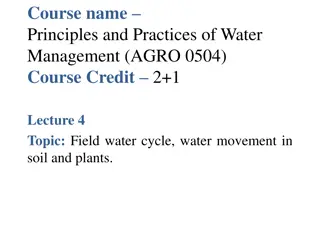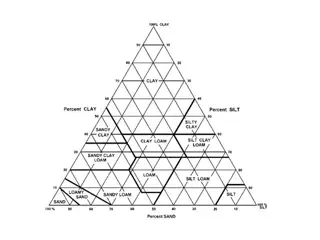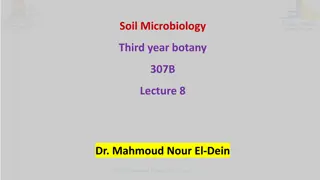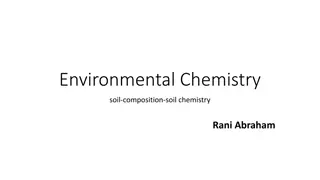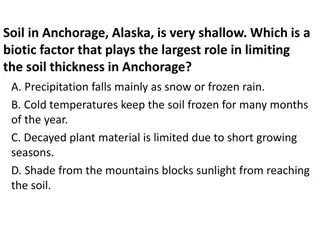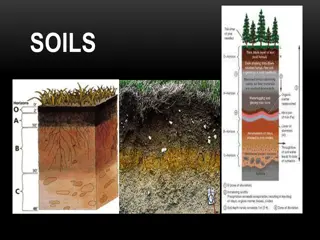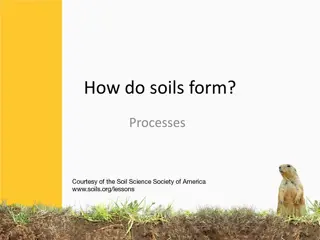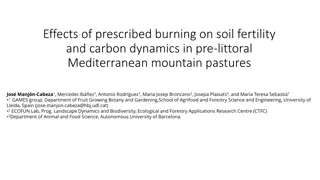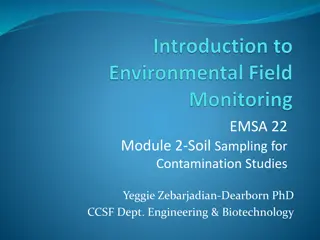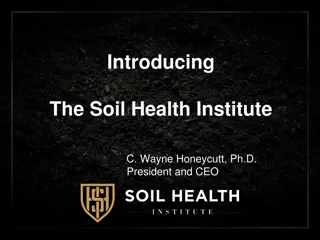The Importance of Humus in Soil Health
Humus, the organic residue in soil, plays a crucial role in soil fertility and plant growth. It improves soil structure, retains water, stores essential nutrients, and promotes microbial activity. Factors like soil fertility, moisture, temperature, and pH influence the distribution and activity of soil microorganisms, impacting overall soil health.
Download Presentation

Please find below an Image/Link to download the presentation.
The content on the website is provided AS IS for your information and personal use only. It may not be sold, licensed, or shared on other websites without obtaining consent from the author.If you encounter any issues during the download, it is possible that the publisher has removed the file from their server.
You are allowed to download the files provided on this website for personal or commercial use, subject to the condition that they are used lawfully. All files are the property of their respective owners.
The content on the website is provided AS IS for your information and personal use only. It may not be sold, licensed, or shared on other websites without obtaining consent from the author.
E N D
Presentation Transcript
Soil Humus Humus is the organic residue in the soil resulting from decomposition of plant and animal residues in soil, or it is the highly complex organic residual matter in soil which is not readily degraded by microorganism, or it is the soft brown/dark colored amorphous substance composed of residual organic matter along with dead microorganisms. Composition of Humus: In most soil, percentage of humus ranges from 2-10 percent, whereas it is up to 90 percent in peat bog. On average humus is composed of Carbon (58 %), Nitrogen (3-6 %, Av.5%), acids -humic acid, fulvic acid, humin, apocrenic acid, and C: N ratio 10:1 to 12:1. During the course of their activities, the microorganisms synthesize number of compounds which plays important role in humus formation.
Functions/Role of Humus: 1-It improves physical condition of soil. 2-Improve water holding capacity of soil. 3-Serve as store house for essential plant nutrients. 4-Plays important role in determining fertility level of soil. 5-It tend to make soils more granular with better aggregation of soil particles. 6-Prevent leaching losses of water soluble plant nutrients.
7) in soil and encourage better development of plant-root system in soil. 8) Act as buffering agent i.e. prevent sudden change in soil PH/soil reaction. 9) Serve as source of energy and food for the development of soil organisms. 10) It supplies both basic and acidic nutrients for the growth and development of higher plants. 11) Improves aeration and drainage by making the soil more porous Improve microbial/biological activity
Factors Affecting Distribution, Activity and Population of Soil Microorganisms Soil microorganisms Fauna), just like higher plants depends entirely on soil for their nutrition, growth and activity. The which influence the microbial population, distribution and their activity in the soil are {1. Soil fertility 2.Cultural practices 3. Soil moisture 4. Soil temperature5. Soil aeration 6. Light 7. Soil PH (H-ion Concentration) 8. Organic matter 9. Food and energy supply 10. Nature of soil and 11. Microbial associations}. (Flora & major soil factors
All these factors play a great role in determining not only the number and type of organism but also their activities. Variations in any one or more of these factors may lead to the changes in the activity of the organisms which ultimately affect the soil fertility level. Brief account of all these factors influencing soil micro flora / organisms and their activities is activities are discussed paragraphs
1. Cultural practices (Tillage): Cultural practices viz. cultivation, crop rotation, application of manures and fertilizers, liming and gypsum pesticide/fungicide and have their effect on soil organism. Ploughing and tillage operations facilitate aeration in soil and exposure of soil to sunshine and thereby increase the biological organisms, particularly of bacteria. Crop rotation with legume maintains the favorable microbial population balance, particularly of N2 fixing bacteria and thereby improve soil fertility. Liming of acid soils increases activity of bacteria and actinomycetes and lowers the fungal population application, weedicide application activity of
. Fertilizers and manures applied to the soil for increased crop production, supply food and nutrition not only to the crops but also to microorganisms in soil and thereby proliferate the activity of microbes. Foliar or soil application of (pesticides, fungicides, nematicides etc.) in agriculture are either degraded by the soil organisms or are toxic residues in soil which are hazardous to cause profound reduction in the normal microbial activity in the soil. different chemicals liable to leave
2. Soil fertility: Fertility level of the soil has a great influence on the microbial population and their activity in soil. The availability of N, P and K required for plants as well as microbes in soil determines the fertility level of soil. 3. Soil moisture: It is one of the influencing the microbial their activity in soil. Water (soil moisture) is useful to the microorganisms in two ways i.e. it serve as source of nutrients and supplies hydrogen / oxygen to the organisms and it serve as solvent and carrier of other food nutrients to the microorganisms. Microbial important population factors &
activity & population proliferate best in the moisture range of 20% to 60%. Under excess moisture conditions / water logged conditions due to lack of soil aeration (Oxygen) anaerobic micro flora become active and the aerobes get suppressed. While in the absence of adequate moisture in soil, some of microbes die out due to tissue dehydration and some of them change their forms into resting stages spores or cysts and tide over adverse conditions. Therefore optimum soil moisture (range 20 to 60 %) must be there for better population and activity of microbes in soil.
4. Soil temperature: Next to moisture, temperature is the most important environmental biological physical & chemical processes and microbes, microbial activity and population in soil. Though microorganisms temperature (such as - 60 or +60 u) conditions, but the optimum temperature microorganisms can grow and function actively is rather narrow. Depending upon the temperature range at which microorganisms can grow and function, are divided into three groups i.e. psychrophiles (growing at low temperature below 10 C) Mesophiles (growing well in the temp range of 20 C to 45 C) and thermophiles (can tolerate temperature above 45 C and optimum 45-60 C). factor influencing the of can tolerate extreme range at which soil
Most of the soil microorganisms are mesophilic (25 to 40 ) and optimum temperature for most mesophiles is 37 C. True psychrophiles are almost absent in soil, and thermopiles though present in soil behaves like mesophiles. True thermopiles are more abundant in decaying manure and compost heaps where high temperature prevails. Seasonal changes in soil temperature affect microbial population activity especially intemperate regions. In winter, when temperature is low (below 50 C ), the number and activity of microorganisms falls down, and as the soils warms up in spring, they increases in number as wellas activity. In general, population and activities of soil microorganisms are the highest in spring and lowest in winter season. and their
5. Soil air (Aeration): For the growth of microorganisms better aeration (oxygen and sometimes CO2) in the soil is essential. Microbes consume oxygen from soil air and gives out carbon dioxide. Activities of soil microbes is often measured in terms of the amount of oxygen absorbed or amount of Co2 evolved by the organisms in the soil environment. Under high soil moisture level / water logged conditions, gaseous exchange is hindered and the accumulation of Co4 occurs in soil air which is toxic to microbes. Depending upon oxygen requirements, soil microorganisms are grouped into categories viz aerobic (require oxygen for like processes),anaerobic (do not require oxygen) and microaerophilic (requiring low concentration / level of oxygen).
6. Light: Direct sunlight is highly injurious to most of the microorganisms except algae. Therefore upper portion of the surface soil a centimeter or less is usually sterile or devoid of microorganisms. Effect of sunlight is due to heating and increase in temperature (More than 45 ) 7. Soil Reaction / Soil PH: Soil reaction has a definite influence / effect on quantitative and qualitative composite on of soil microbes.
Most of the soil bacteria, blue-green algae, diatoms and protozoa prefer a neutral or slightly alkaline reaction between PH 4.5 and 8.0 and fungi grow in acidic reaction between PH actinomycetes prefer slightly alkaline soil reactions. Soil reactions also influence the type of the bacteria present in soil. For bacteria(Nitrosomonas diazotrophs like Azotobacter are absent totally or inactive in acid soils, like Beijerinckia, Derxia, and sulphur oxidizing bacteria like Thiobacillus thiooxidans are active in acidic soils. 4.5 and 6.5 while example Nitrobacter) nitrifying & and while diazotrophs
8. Soil Organic Matter: The organic matter in soil being the chief source of energy and food for organisms, it has great influence on the microbial population. Organic matter indirectly on the population and activity of soil microorganisms. It influences the structure and texture of soil and thereby activity of the microorganisms. 9. Food and energy supply: Almost all microorganisms obtain their food and energy from the plant residues or organic matter / substances added to the soil. Energy is required for the metabolic activities of heterotrophs utilize the energy liberated during the oxidation of complex organic compounds in soil, while autotrophs meet their energy most of the soil influence directly or microorganisms. The
requirement inorganic compounds (chemoautotroph) or from solar radiation(Photoautotroph). Thus, the source of food and energy rich material is essential for the microbial activity in soil. The organic matter, therefore serves both as a source of food nutrients as well as energy required by the soil organisms. form oxidation of simple
10. Nature of Soil: The physical, chemical and physico-chemical nature of soil and its nutrient status influence the microbial population and qualitatively. The chemical nature of soil has considerable effect on microbial population in soil. The soils in good physical condition have better aeration and moisture content which is essential for optimum microbial activity. Similarly nutrients (macro and micro) and organic constituents of humus are responsible for absence or presence of certain type of microorganisms and their activity. For example activity and presence of nitrogen fixing bacteria is greatly influenced by the availability of molybdenum and absence of available phosphate restricts the growth of Azotobacter. both quantitatively
11. Microbial associations / interactions: Microorganisms interact with each other giving rise to antagonistic or symbiotic interactions. The association existing between one another whether of symbiotic influences the population and activity of soil microbes to a great extent. The predatory habit of protozoa and some mycobacteria which feed on bacteria may suppress or eliminate certain bacteria. On the other hand, the activities of some of the microorganisms are beneficial to each other. For instance organic acids liberated by fungi, increase in oxygen by the activity of algae, change in soil reaction etc. favors the activity or bacteria and other organisms in soil. organism and or antagonistic
12. Root Exudates: In the soil where plants are growing the root exudates also affects the distribution, density and activity of soil microorganism. Root exudates and sloughed off material of root surfaces provide an abundant source of energy and nutrients and or indirectly influence the quality as well as quantity of microorganisms in the rhizosphere region. Root exudates contain sugars, organic acids, amino acids, sterols, vitamins and other growth factors which have the profound effect on soil microbes. thus directly


